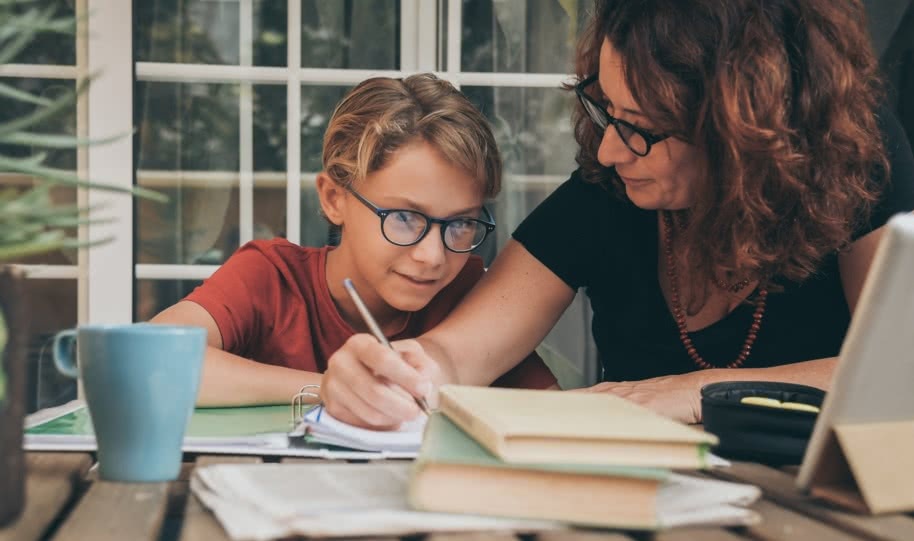How can you help support your child or teenager with their learning at home?
You may have been given schoolwork to do with your child at home and it is important to state that the majority of parents are not trained or experienced educators, and nobody expects you to be. Don’t put unnecessary pressure on yourself.
Below are 10 top tips to support homeschooling:
- Prioritise mental health. Very little learning will take place if your child is highly anxious. Therefore, ease off the schoolwork if this is the case. Focus on your child’s wellbeing and get to the learning later.
- Keep in touch with the school. If your child is having difficulties with homeschooling, discuss this with your child’s teacher if you can. Your child’s teacher will be able to offer suggestions and ideas to support you as they know your child as a learner better than anybody else.
- Look for positive opportunities. Some children and teenagers find the school environment incredibly stressful. Therefore, the opportunity to learn at home could be a wonderful opportunity for them to really engage in a piece of learning and an opportunity for you to create some memorable experiences with your child. Learning can take place at any time and could this be a time to develop skills with your child that might not be offered in schools, for example, cooking, gardening, DIY.
- Building confidence. One of the pillars of children’s self-confidence lies in knowing that they are good at something and have a good level of skill or knowledge in a particular area. No one can be good at everything. Help your child identify their interests/passions and structure your child’s learning time to provide time for development. This is important with teenagers who will want time away from their parents and carers. There’s an opportunity here for your child to have the time to really explore one particular area of interest.
- Explore assistive technology. There’s an opportunity to look into technology that can assist your child’s learning and discover tools and resources that their teacher may be unaware of or is unavailable to use in school.
- How does your child like to learn? Revisit conversations that you have had with your child about their learning. Ask what works well. Does your child always like to sit at a table? What sort of activities do they enjoy? What helps your child to remember? Then build learning experiences from this that are more likely to engage your child’s interest in learning.
- Ask yourself two important questions- “What is learning?” and “What does learning success look like for my child?” For example, your child has been asked to learn about a particular subject then to produce a written piece on that subject. However, you know that your child is going to find the written piece challenging. If, by the end of the learning experience, your child has engaged with the subject, has asked some interesting questions about it and has been able to talk about it with some knowledge and understanding, this is learning. If then the written piece produced contains many mistakes or is difficult to understand, don’t think that this learning experience has been a failure. You are probably not a specialist literacy teacher. Go for interest and engagement every time. This is especially important if your child has a diagnosed learning difficulty.
- Routine and environment. It is important to establish a routine. This simply means the time to be spent in learning and to build in breaks. Timers can be useful here unless they cause anxiety which will interfere with the learning. Speak to your child’s teacher for guidance and always be ready to be flexible with this and alter timings if needed. Ask yourself, what is the best time for my child to learn? Teenagers, for example, might need a slightly later start than younger children. If you are going to create a “working space,” think about peripheral and external distraction and remove any items that are not necessary for the activity, for example, phones, tablets etc. Before you begin, create a tray or box that will contain all the equipment that your child will need to do the specific activity at hand. Remember, lots of children do not want to learn sitting at a desk. Your child might prefer to stand or lie on the floor. If your child is struggling to pay attention, then movement and varied stimuli can help. You could expand the learning environment so that your child must move to find the information that they need.
- Consider learning conventions. Discuss with your child how they want to work with you. Some children may require a lot of adult support with certain tasks, for others this will be a distraction. You could establish a routine here - a period of working and then your child reports back to you to discuss what has been learnt. Some children like to subvocalise or talk along as they learn, including whilst reading. The general rule is that if your child is engaged and doing what is required, do not distract them - leave them alone.
- Planning and organisation. If your teenager has been asked to undertake a lengthy project-based piece of work which involves a degree of organisation, planning, and time management skills, this can appear overwhelming for some young people and they might experience difficulties starting. Discuss this with your child before they start. Think about breaking the task down into distinct, time defined sections with achievable targets. Build in breaks and milestone reviews to encourage your child to monitor their own progress and think about an element of reward. Rewards could include time spent on their own interests and passions.
“There’s a real opportunity here for parents to offer learning that is not offered in schools”
- Colin Foley
Listen to our Podcast with Colin Foley here!
